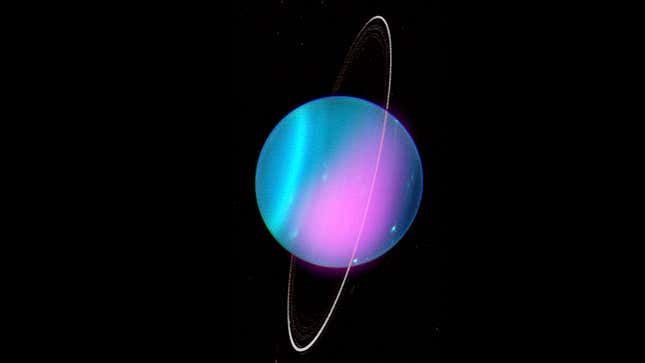
Using NASA’s Chandra X-ray Observatory, astronomers have detected X-rays coming from Uranus, revealing a previously unknown dimension of this majestic ice giant.
The new finding, published in JGR: Physics, means that X-ray emissions have been detected on every planet in the solar system except Neptune. What’s more, the discovery could yield new insights into more distant X-ray-emitting objects, including black holes, supernovae, quasars, and neutron stars. The new paper was led by astronomer William Dunn from University College London.
Composed primarily of hydrogen and helium, Uranus exhibits two sets of rings, both in orbit above its equator. The planet is somewhat of an oddball, as it rotates on its side relative to the plane of the solar system (no other planet does this). NASA’s Voyager 2 spacecraft visited Uranus very briefly in 1986, so aside from that, astronomers have been depending on telescopes, such as Chandra and Hubble, to study the seventh planet from the Sun.
Dunn, along with physicist Affelia Wibisono, a PhD student at UCL and a co-author of the study, uncovered the evidence of Uranus’s X-ray emissions in Chandra data gathered in 2002 and 2017. The data from 2002 was gathered by the Chandra Advanced CCD Imaging Spectrometer, while the 2017 data came from Chandra’s High Resolution Camera, in addition to optical observations. The observed signals are very weak, but they’re there.
With X-rays confirmed on Uranus, the challenge now is to determine the cause.
“There are three main ways that a planet can produce X-rays: fluorescence, scattering of solar X-rays, and auroral emissions,” explained Wibisono in an article she wrote for the Chandra website.
Uranus, like many other objects in the solar system—including comets, moons, and even the dwarf planet Pluto—is likely scattering X-rays received by the Sun. But this doesn’t appear to be the exclusive source of X-rays on Uranus. As Wibisono points out, “our calculations suggest that Uranus was producing more X-rays than it should if the planet was only scattering the Sun’s X-rays.”
The authors proposed two different theories to explain the emissions. One possibility is that Uranus’s rings are churning out X-rays, similar to what’s happening with the rings around Saturn. This process, known as fluorescence, happens when energetic charged particles, such as electrons and protons, collide with the rings, causing them to glow in X-rays.
Another possibility is that the X-rays are being produced by Uranus’s auroras, as NASA explains in a statement.
On Earth, we can see colorful light shows in the sky called auroras, which happen when high-energy particles interact with the atmosphere. X-rays are emitted in Earth’s auroras, produced by energetic electrons after they travel down the planet’s magnetic field lines to its poles and are slowed down by the atmosphere. Jupiter has auroras, too. The X-rays from auroras on Jupiter come from two sources: electrons traveling down magnetic field lines, as on Earth, and positively charged atoms and molecules raining down at Jupiter’s polar regions.
Trouble is, the cause of auroras on Uranus is still poorly understood, so much of this remains guesswork. Further “observations of Uranus by Chandra and other X-ray telescopes are needed before we can give a definitive answer,” admits Wibisono.
Uranus presents a fascinating object for studying various aspects of the distant planets, and that’s on account of its unusual spin axis and wonky magnetic field. With its odd tilt, astronomers can see Uranus at an irregular angle, and due to its magnetic field, which is also weirdly tilted, astronomers could eventually find a connection with the planet’s complex and variable auroras. There’s still plenty to learn about this strange and wonderful ice giant.